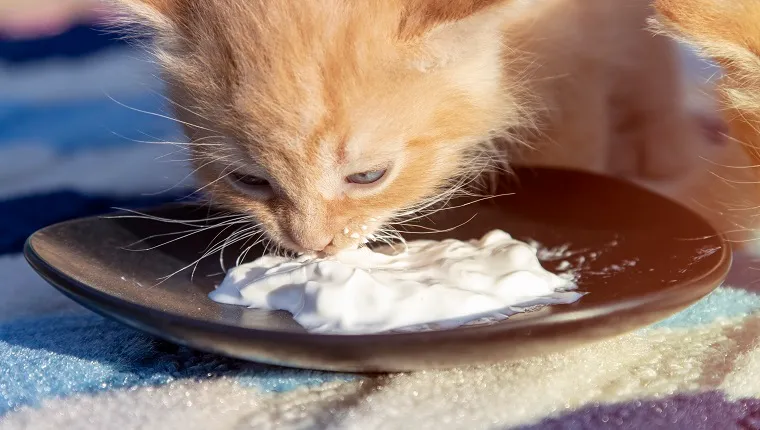Table of Contents
Table of Contents
Whipped cream is a sweet, creamy treat that many humans love — and pet parents often wonder if it’s safe to share with their pets. Whether you’ve taken your dog to a coffee shop for a Puppuccino or are curious about letting your cat try a tiny taste, questions like “Can dogs have whip cream?” or “Can cats have whipped cream?” are very common.
In this comprehensive guide, we’ll cover:
- What whipped cream contains
- Health risks for cats and dogs
- Safe amounts and alternatives
- Homemade vs. store-bought whipped cream
- FAQs covering both species
By the end, you’ll understand whether whipped cream can be an occasional treat or if it’s better left to humans.
What Is Whipped Cream Made Of?
Whipped cream is made from heavy cream that has been aerated to create a light, fluffy texture. Many store-bought or café versions also include:
- Sugar – plain sugar or corn syrup
- Flavorings – such as vanilla or chocolate
- Stabilizers – to maintain texture
- Non-dairy ingredients – like plant-based cream in vegan varieties
For example:
- Starbucks Puppuccinos typically contain only plain whipped cream without chocolate or syrups, making them relatively safer for dogs in moderation.
- Canned whipped cream often contains added sugar, artificial sweeteners like xylitol, or stabilizers that could be harmful to pets.
💡 Vet Tip: Always check the ingredient list before giving whipped cream to your pets. Avoid any product with xylitol, chocolate, or artificial sweeteners.
Can Dogs Have Whipped Cream?
Dogs can safely consume small amounts of plain whipped cream occasionally. However, there are several important considerations:
1. Risks of Whipped Cream for Dogs
- Lactose intolerance: Many dogs have trouble digesting lactose, which can lead to diarrhea, vomiting, or stomach upset.
- High fat content: Too much fat can contribute to obesity and even pancreatitis in sensitive dogs.
- Sugar content: Sugar can lead to weight gain and dental issues over time.
- Xylitol: A sugar substitute found in some whipped creams, xylitol is extremely toxic to dogs and can cause hypoglycemia, seizures, or liver failure.
2. Safe Practices for Feeding Dogs Whipped Cream
- Give occasional small amounts, such as a teaspoon for small dogs or a few tablespoons for large dogs.
- Stick to plain, unsweetened whipped cream.
- Monitor your dog for any signs of stomach upset or allergic reaction.
3. Healthy Alternatives for Dogs
If you want to treat your dog safely without the risk of sugar or lactose:
- Plain yogurt (lactose-free if needed)
- Mashed pumpkin or sweet potato
- Dog-safe peanut butter (ensure it’s xylitol-free)
✅ Bottom line: Dogs can enjoy whipped cream as a rare treat, but it should never be part of a daily diet.
Can Cats Have Whipped Cream?
Cats are obligate carnivores, meaning their diet should be primarily animal protein. While whipped cream is non-toxic to cats, it is not recommended as a regular treat.
1. Risks of Whipped Cream for Cats
- Lactose intolerance: Most cats are lactose intolerant, so even a small amount can cause diarrhea, vomiting, or stomach discomfort.
- High fat content: Cats have a harder time digesting fat, which can contribute to obesity or pancreatitis.
- Sugar: Cats cannot taste sweetness and don’t require sugar in their diet. High sugar intake provides empty calories and can affect their health.
- Artificial ingredients: Flavored whipped creams may contain harmful additives, such as xylitol or alcohol in vanilla extract.
2. Safe Practices for Feeding Cats Whipped Cream
- Only offer very small amounts occasionally, such as a tiny dollop on a spoon.
- Use plain dairy-free or lactose-free whipped cream if possible.
- Limit treats to once in a while, not daily.
3. Why Cats May Be Interested in Whipped Cream
Cats may be drawn to whipped cream because of its fat content, not its sweetness. Many cats are curious about foods their humans enjoy and may want to try whatever you’re eating.
4. Healthy Alternatives for Cats
Instead of whipped cream, consider these safe options:
- Small bites of cooked chicken or turkey
- Pumpkin puree (unsweetened)
- Commercial cat treats designed for their dietary needs
💡 Fun fact: While cats may enjoy licking whipped cream, it provides no real nutritional benefit. It’s essentially empty calories that can lead to health problems if given regularly.
Whipped Cream From Coffee Shops
Many pet owners are familiar with Puppuccinos or Starbucks whipped cream cups. Here’s what to know:
- Dogs: Puppuccinos are generally safe in small amounts for healthy dogs. Avoid any chocolate or flavored syrups.
- Cats: Occasionally tasting whipped cream is fine, but cats don’t gain much nutritional benefit and may experience gastrointestinal upset.
- Always avoid whipped cream containing xylitol or other artificial sweeteners.
Homemade vs. Store-Bought Whipped Cream
Homemade whipped cream:
- Made from heavy cream without added sugar or flavorings
- Safer because you control all ingredients
Store-bought/canned whipped cream:
- Often contains added sugars, stabilizers, or harmful ingredients
- Always read labels carefully to ensure pet safety
💡 Vet Tip: If in doubt, skip whipped cream entirely and opt for a pet-safe treat.
How Much Whipped Cream Is Safe for Pets?
- Dogs:
- Small breeds: 1 teaspoon
- Medium breeds: 1–2 tablespoons
- Large breeds: 2–3 tablespoons occasionally
- Cats:
- Less than 1 teaspoon occasionally
Monitor your pet for any signs of vomiting, diarrhea, or lethargy. Daily consumption is never recommended due to fat and sugar content.
FAQs About Whipped Cream for Dogs and Cats
Q1: Can dogs have whipped cream every day?
No. Even small daily amounts can cause digestive upset, obesity, or pancreatitis.
Q2: Can cats have whipped cream as a treat?
Yes, but only in very small amounts occasionally. It should not be a part of their regular diet.
Q3: Can cats have whipped cream from Starbucks?
Occasional tasting is fine, but avoid flavored versions or those with syrups. Watch for GI upset.
Q4: Can cats have non-dairy or plant-based whipped cream?
Yes, if unsweetened and xylitol-free, but give sparingly.
Q5: Are dogs and cats allowed to have whipped cream?
Yes, in moderation and plain varieties only, but it should never replace balanced pet food.
Q6: What happens if pets eat too much whipped cream?
They may experience vomiting, diarrhea, gas, or pancreatitis, and overfeeding long-term can lead to obesity.
Q7: Can whipped cream cause diarrhea in cats or dogs?
Yes, especially if they are lactose intolerant or consume large amounts. Monitor your pet after introducing any new treat.
Tips for Pet Parents
- Moderation is key — small dollops are safe occasionally.
- Check ingredients — avoid sugar, chocolate, and xylitol.
- Use alternatives — healthy pet-safe treats like pumpkin, yogurt, or cooked meats.
- Monitor your pet — any signs of digestive upset should be addressed promptly.
🐾 Telavets Recommendation: If you’re ever unsure about sharing a treat or introducing a new food, consult with a Telavets online vet. Our licensed veterinarians can guide you on safe options for both dogs and cats, based on age, weight, and health conditions.
Final Thoughts
While dogs and cats can technically eat whipped cream, it should never be a regular treat. Whipped cream provides no nutritional value, is high in fat and sugar, and can cause digestive issues.
- Dogs may enjoy it occasionally in small amounts.
- Cats may lick a tiny taste, but it is not beneficial and can cause GI issues.
- Always prioritize pet-safe alternatives and moderation.
By following these guidelines, you can safely share a tiny treat with your pets while keeping them healthy and happy.

